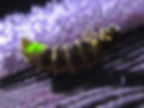Glow-Worms: Nature’s Lanterns in World War I Trenches
- Amy M. O'Quinn
- Sep 21, 2016
- 3 min read

One of my favorite childhood memories is chasing lightning bugs (or fireflies) through the dusky evening woods as the bioluminescent greenish lights from their tiny abdomens flashed on and off. It was magical! In fact, catching the little critters and cupping them in my hands, or temporarily placing a few in a jar for observation, was as much a rite of summer as eating popsicles or building sandcastles!
But who knew that this species from the Lampyridae family also aided soldiers in the trenches of World War I? It’s true! Along with horses, mules, camels, pigeons, dogs, and cats, glow-worms played a part in helping the Allied soldiers do their jobs.
What is the difference between fireflies or lightning bugs and glow-worms?
Just for information purposes, specific members of the Lampyridae family might have a different identification, depending on where you live. In the United States, all Lampyridae species are called lightning bugs or fireflies, and the wingless larvae of both are called glow-worms. All of them can produce short flashes of light.
As in America, European fireflies have the same characteristics—they look similar and both sexes can fly and emit light. However, the glow-worms are categorized differently. Glow-worm females look more like larvae than the adult male. They produce bright emissions of intermittent light, but they cannot fly. The adult males can fly, but they produce very little, or at least very faint, light. They are called Lampyridae noctiluca or European glow-worms.

Female European Glow-Worm--not attractive, but very efficient and bright!
Trench Glow
So, how did this bioluminescent beetle aid the Allies? Imagine weary soldiers huddling in the trenches at night, needing to read a map, report, or a letter from home. Lighting a lantern or firing up a lighter was too risky and might draw enemy fire.

WWI soldiers in a trench
What could they do?
Collect some glow-worms producing incandescent cold-light in their abdomens through an internal chemical process, put them in a jar or bottle, and voila! The men had a softly glowing light source. It wasn’t very bright, but depending on the number of glow-worms collected, there was enough light for reading. If the soldiers needed brighter light, they might collect thousands of glow-worms. Nature’s luminous lantern made from Lampyridae noctiluca specimens!
What Causes the Light?
Do you want to know more about what makes a glow-worm (or firefly/lightning bug) produce light? Find out here.
Fireflies Are Fascinating!
Want even more information about fireflies? Click here to read some neat firefly facts.
Read On!
If you’d like to find out more about interesting events and organizations from the World War I era, consider reading my book, Marie Curie for Kids: Her Life and Scientific Discoveries, with 21 Activities and Experiments. It will be released on November 1, 2016.
(Affiliate link)
Marie Curie made many contributions to the Great War. Most notably, she outfitted and drove mobile radiological cars (called Little Curies) to the French battle front. She worked tirelessly, night and day, helping doctors and medics X-ray wounded soldiers in an effort to locate bullets, broken bones, and internal injuries—in case surgery was needed right there at the field hospital. This early intervention saved thousands of lives!
The book includes fun activities, such as reading real World War I X-rays and comparing your diagnosis to the doctor’s actual notes, building a Little Curie from a small cardboard box, and stepping into the shoes (and minds) of a doctor, medic, nurse, X-ray technician, or ambulance driver to write a creative journal entry or letter home.
Check it out!




